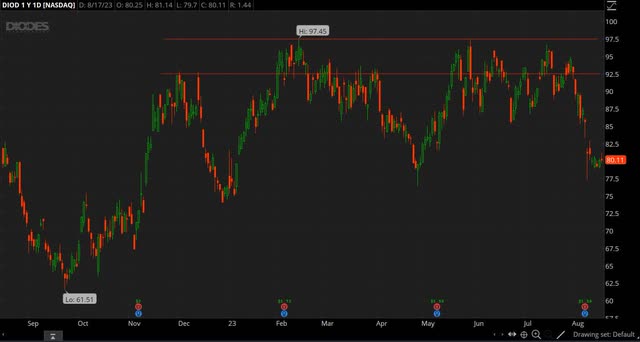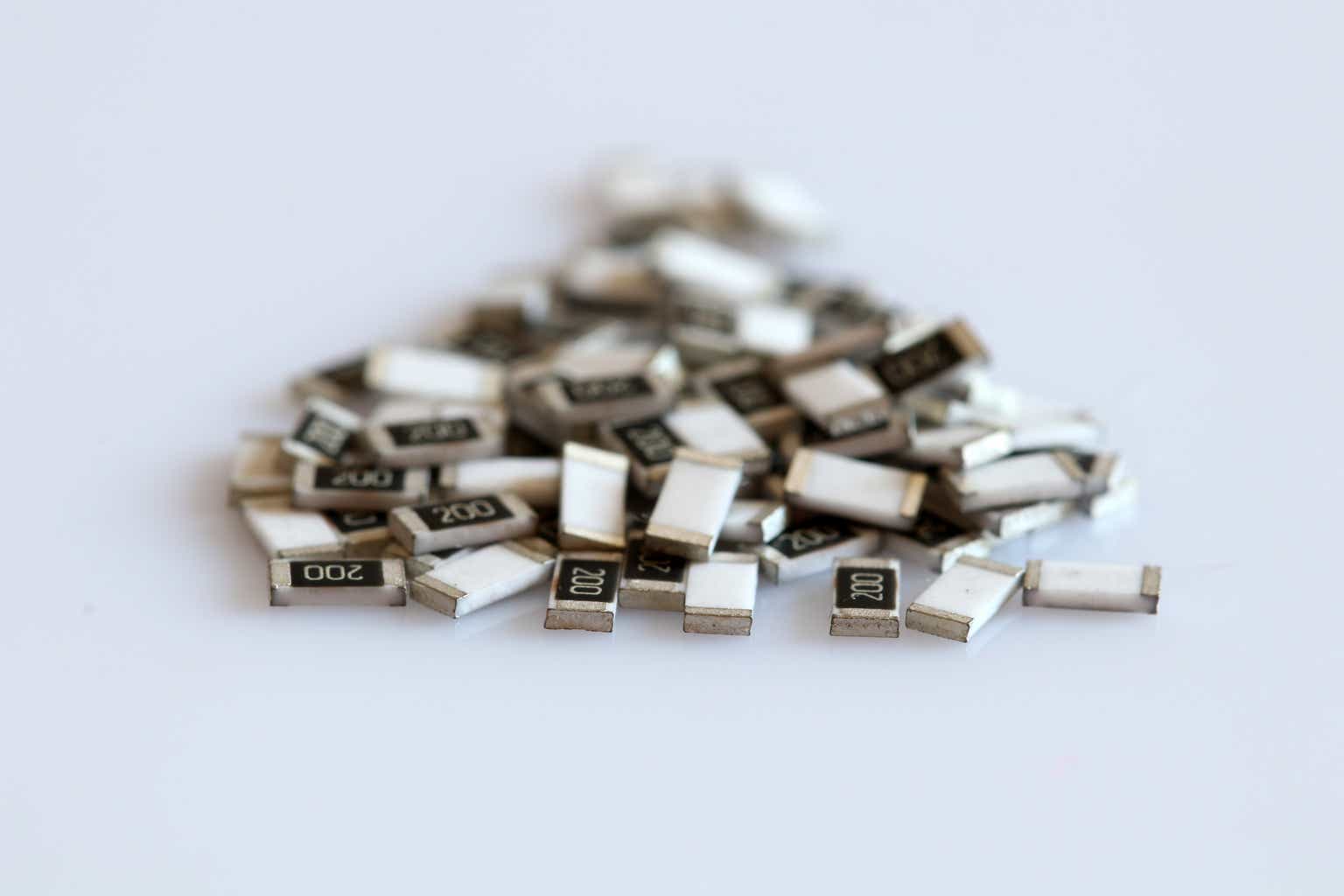Diodes Incorporated (NASDAQ:DIOD), a supplier of discrete semiconductors, released its Q2 report on August 8 that came in mixed. On the one hand, while DIOD is still dealing with a surplus of inventory in the market due to a slump in demand, DIOD also reported seeing initial signs of a recovery in demand. On the other hand, guidance was much weaker than expected as DIOD acknowledged the market is not recovering as quickly as it thought it would. As a consequence, it appears the stock may remain stuck for a while longer. Why will be covered next.
The Q2 numbers came in as expected
The Q2 numbers were in line with guidance from DIOD. Q2 revenue declined by 6.8% YoY to $467.2M and non-GAAP EPS declined by 16.3% YoY to $1.59 as DIOD continues to face a slump in demand and elevated inventories. GAAP EPS increased by 14.9% QoQ and 1.1% YoY to a much better-than-expected $1.77, but it’s worth mentioning that the increase would not have happened if not for a $12.2M unrealized gain on an investment. DIOD continued to pay off the debt on its balance sheet as long-term debt fell to $54.6M, down from $147.5M a year ago. Cash, cash equivalents and short-term investments declined slightly to $333.7M. The table below shows the numbers for Q2 FY2023.
|
(Unit: $1000, except EPS) |
|||||
|
(GAAP) |
Q2 FY2023 |
Q1 FY2023 |
Q2 FY2022 |
QoQ |
YoY |
|
Revenue |
467,152 |
467,241 |
500,972 |
(0.02%) |
(6.75%) |
|
Gross margin |
41.8% |
41.6% |
41.2% |
20bps |
60bps |
|
Income from operations |
89,567 |
86,427 |
106,238 |
3.63% |
(15.69%) |
|
Net income (attributable to common stockholders) |
82,020 |
71,150 |
80,155 |
15.28% |
2.33% |
|
EPS |
1.77 |
1.54 |
1.75 |
14.94% |
1.14% |
|
(Non-GAAP) |
|||||
|
EBITDA |
133,452 |
121,779 |
130,646 |
9.59% |
2.15% |
|
Net income (attributable to common stockholders) |
73,333 |
73,446 |
86,902 |
(0.15%) |
(15.61%) |
|
EPS |
1.59 |
1.59 |
1.90 |
– |
(16.32%) |
Source: DIOD Form 8-K
However, guidance was a disappointment. Guidance calls for Q3 FY2023 revenue of $425M, plus or minus 3%, a decline of 9% QoQ and 18.5% YoY at the midpoint as shown below. Gross margin is expected to decline to 40%, plus or minus 1%. Based on these datapoints, DIOD is estimated to post non-GAAP EPS of $1.21 on revenue of $425M in its next report.
|
Q3 FY2023 (guidance) |
Q3 FY2022 |
YoY (midpoint) |
|
|
Revenue |
$425M, +/- 3% |
$521.3M |
(18.47%) |
|
GAAP gross margin |
40.0%, +/- 1% |
41.8% |
(180bps) |
Keep in mind that DIOD had previously suggested the second half of FY2023 would be stronger than the first half, which no longer looks attainable given that Q3 guidance calls for a sequential decline in earnings and revenue due to persistent weakness in markets that were expected to bounce back. From the Q1 FY2023 earnings call:
“the overall market situation, okay, we see some recovery on the 3C market, but the industrial and automotive are still very strong and therefore, we are hoping that second half of this year after the channel inventory or as you said, our customer as a building up and their inventory of the 3C product start to decrease, then, the second half the business should be come back stronger.”
Wall Street estimates have dialed back expectations as a consequence and are now calling for DIOD to earn $5.47-5.65 on revenue of $1.77-1.79B in FY2023 after earning $3.18 in the first half. In comparison, DIOD earned $7.36 on revenue of $2B in FY2022.
Management added some color as to what appears to be a lowering of the outlook. On the positive side, DIOD is seeing some signs the market is getting better with fewer inventory around. From the Q2 earnings call:
“In summary, we have begun to see early indications of market improvement with inventory days decreasing in the second quarter coupled with an increased worldwide POS revenue. Our focus going into the third quarter continues to be on POS growth and depleting channel inventory.”
A transcript of the Q2 FY2023 earnings call can be found here.
On the negative side, the recovery is slower than expected. Ditto for inventory depletion, which is going slower than expected.
“Also because, like I mentioned, even there are some signs of recovery but the recovery is definitely slower than what we expected. So I would say the depleting of the channel inventory is slower than our expectation as well. That’s the reason we guided a lower number for the third quarter.”
The 3C markets were weaker than expected, partially offset by continued strength in the automotive market.
“The recovery in the consumer computing and communications market was much slower than we had originally expected, whereas the trend in the automotive market remained relatively strong.”
China, and Asia in general, was another factor that weighed on demand.
“During the second quarter, the recovery in the Asian market was slower than we expected especially in China.”
Overall, the latest updates from DIOD were a letdown, because while there were some positives, they were more than offset by the negatives. As a result, the outlook was lowered with guidance calling for business to contract when the opposite was expected.
Resistance has held its ground all year
The chart below showed how the Q2 report pushed the stock lower. Notice how the stock has struggled to overcome what appears to be resistance in the $92.5-97.5 region. The stock has tried all year to get past this region with numerous attempts, but all have been rejected. A previous article from last December noted how the stock was likely to face resistance when it reached the $90-95 region, which proved to be warranted since eight months have passed with not much progress since then.
Source: Thinkorswim app
However, there seems to be some level of support for the stock in the $75-80 region. Notice how both pullbacks in the stock in 2023 ended in the aforementioned region. The stock got as low as $76.43 on April 27 and it got as low as $77.28 on August 9 after the disappointing Q2 report. Further attempts by the stock to go lower were met by buyers, suggesting the presence of support. The stock could be stuck between resistance in the $92.5-97.5 region and support in the $75-80 region. DIOD could therefore continue to stay range-bound for some time.
Why DIOD is worth keeping an eye on
Sideways action is unlikely to be exciting for most investors, but there are still a couple of reasons why DIOD is worth keeping track off. DIOD could be seen as a relatively affordable way to play the ongoing shift in the automotive sector towards increased digitalization and digitization. Automotive actually accounts for 19% of revenue at DIOD after growing at a CAGR of 30% in FY2013-2022. With automotive demand remaining robust, this percentage is likely to go up.
Yet this exposure to the automotive market does not come with a steep price. For instance, DIOD comes with an EV/EBITDA in the single digits. Not only does DIOD trade below its average for the last five years, but it also trades way below the median in the sector. The table below shows some of the multiples DIOD trades at.
|
DIOD |
Sector median |
5-year average |
|
|
Market cap |
$3.68B |
– |
– |
|
Enterprise value |
$3.54B |
– |
– |
|
Revenue (“ttm”) |
$1,981.9M |
– |
– |
|
EBITDA |
$517.5M |
– |
– |
|
Trailing non-GAAP P/E |
11.58 |
19.28 |
18.42 |
|
Forward non-GAAP P/E |
14.48 |
22.87 |
16.93 |
|
Trailing GAAP P/E |
11.15 |
24.93 |
22.00 |
|
Forward GAAP P/E |
14.63 |
25.45 |
19.04 |
|
PEG GAAP |
0.73 |
0.71 |
– |
|
P/S |
1.87 |
2.72 |
2.11 |
|
P/B |
2.20 |
2.94 |
2.64 |
|
EV/sales |
1.82 |
2.80 |
2.10 |
|
Trailing EV/EBITDA |
6.85 |
14.85 |
9.52 |
|
Forward EV/EBITDA |
7.82 |
14.85 |
8.85 |
Source: Seeking Alpha
It’s also worth mentioning that the market for discrete semiconductors is growing, unlike other types of semiconductors. For instance, the latest forecast from WSTS predicts the market for discrete semiconductors will grow by 5.6% YoY in 2023 and by 6.4% in 2024. This could help DIOD outperform versus other semis that are seeing their market contract. Keep in mind the projected decline of about 10% for DIOD in FY2023 revenue after a record-breaking year in FY2022 is actually better than most in the semiconductor space.
Investor takeaways
DIOD was in position to break through the resistance that has kept the stock from going higher for all of 2023, but the Q2 report failed to deliver the boost that a fair amount of people had expected. There were some expectations that DIOD would deliver a beat given the comments it had made in the prior report that called for a stronger H2, which helps explain why the stock was attempting to push higher in the weeks and months preceding the Q2 report, including numerous attempts to breach resistance.
Unfortunately, DIOD came up short by essentially lowering the outlook. Instead of expansion, Q3 guidance calls for a fairly large contraction. While DIOD is seeing some signs of inventory easing up with demand improving, the recovery it was looking for is not going the way DIOD expected it to. The results send the stock tumbling back.
The stock seems to be caught between support and resistance, which suggests that continued sideways action is in store for the stock. This has been the case for all of 2023 and the latest report from DIOD did not have what it takes to break the stalemate. The Q2 report was itself a mix of pluses and minuses, which argues in favor of a stock that may not be worth selling, but not worthy of buying either.
I am neutral on DIOD. DIOD has essentially traded within a range for a whole year. Rallies have been followed by selloffs and vice versa. Those who are into trading stocks and are skilled in knowing when to get in and out might find this interesting. Basically, some may want to be a buyer when the stock is close to a known support level and a seller when the stock gets close to a known resistance level.
Others, though, may determine that sideways action is unlikely to result in the kind of gains one is looking for. If DIOD is to break through the resistance that it has been unable to breach all year, it will have to return to growth. A return to growth is unlikely when inventories remain elevated and inventories are unlikely to come down much if demand remains sluggish, barring some exceptions.
Bottom line, DIOD is worth keeping track of as it does come with a number of appealing attributes. But except for a handful of traders, most should not expect much in the way of returns in the near term. The stock is stuck between two opposing forces, as it has for over a year. As long as this remains the case, long DIOD is likely not the way to go.
Read the full article here








